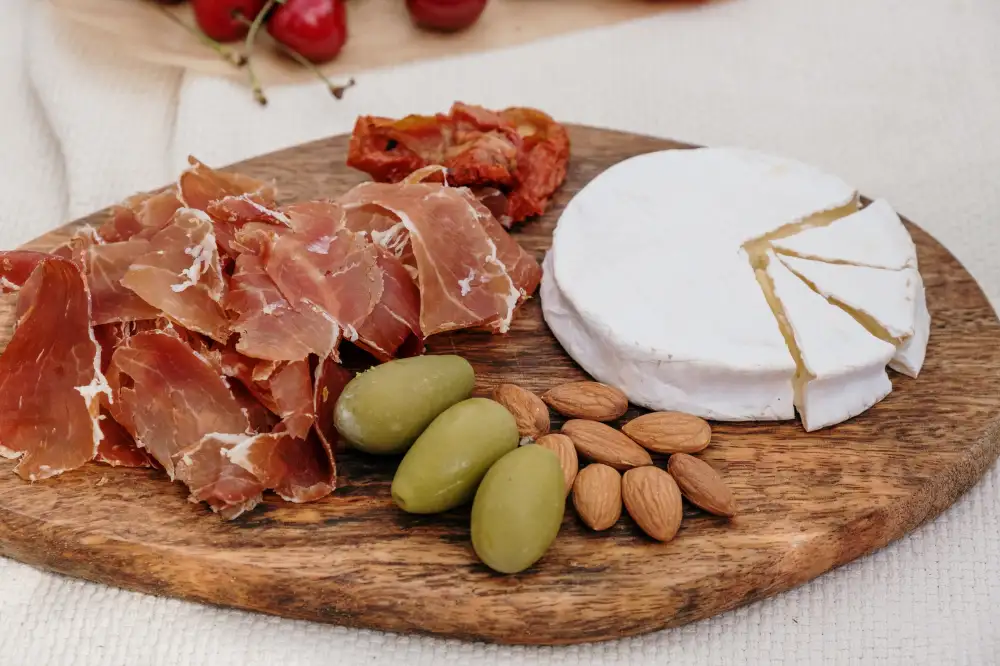Deliciously Melting: Mastering the Art of Cooking Camembert Cheese

- Step 1: Preparing the camembert cheese
- Step 2: Choosing the right baking dish
- Step 3: Preheating the oven
- Step 4: Placing the camembert cheese in the dish
- Step 5: Adding flavorings (optional)
- Step 6: Baking the camembert cheese
- Step 7: Checking for doneness
- Step 8: Serving and enjoying the cooked camembert cheese
Camembert cheese, with its creamy and rich flavor, is a delight for cheese lovers. This soft, bloomy-rind cheese originated in France and has gained popularity worldwide. Cooking camembert cheese takes it to a whole new level, transforming it into a gooey and indulgent treat. Whether you're hosting a dinner party or simply craving a comforting snack, mastering the art of cooking camembert cheese will surely elevate your culinary skills. In this article, we will guide you through the steps to achieve that perfectly melted camembert cheese that will leave your taste buds dancing with joy. So let's dive into the world of deliciously melting camembert!
Step 1: Preparing the camembert cheese
Start by removing the packaging from the camembert cheese and place it on a clean cutting board. Use a sharp knife to gently score the top of the cheese in a crisscross pattern. This will help the cheese to melt evenly during baking. Be careful not to cut too deep as you want to keep the cheese intact.
Next, let the camembert cheese sit at room temperature for about 30 minutes. This will allow it to soften slightly and enhance its creamy texture when baked. While waiting, preheat your oven to 350°F (175°C) so it's ready when you're done preparing the cheese.
Preparing the camembert cheese is an important step as it ensures that it melts perfectly and becomes oozy and delicious when baked. So take your time and handle it with care to achieve the best results in your cooking journey with camembert cheese.
Step 2: Choosing the right baking dish
Choosing the right baking dish is crucial when cooking camembert cheese. Opt for a small, oven-safe dish that is just slightly larger than the cheese itself. A ceramic or glass dish works best as it distributes heat evenly and helps to achieve that perfect gooey texture. Avoid using metal dishes as they can cause the cheese to overcook or develop an unpleasant metallic taste. Remember, the size and material of your baking dish will greatly impact the final result, so choose wisely to ensure a deliciously melted camembert experience.
Step 3: Preheating the oven
Before baking your camembert cheese, it is crucial to preheat the oven to the correct temperature. This ensures that the cheese melts evenly and attains that perfect gooey texture.
Set your oven to 350°F (175°C) and allow it to preheat for about 10-15 minutes. This will give you enough time to prepare the cheese and choose any additional flavorings you might want to add.
Remember, a properly preheated oven is essential for achieving that deliciously melted camembert cheese. So be patient and let the oven reach its optimal temperature before moving on to the next step.
Step 4: Placing the camembert cheese in the dish
Once you have prepared the camembert cheese by removing any packaging, it's time to place it in a suitable baking dish. Choose a dish that is oven-safe and just big enough to hold the cheese without too much extra space.
Gently transfer the camembert cheese into the dish, making sure to keep it intact. You can use a spatula or your hands for this step. Be careful not to break or damage the cheese as you handle it.
Ensure that the top of the cheese is facing up, as this will allow it to melt evenly during baking. If there is any excess liquid or moisture on the surface of the cheese, pat it dry with a paper towel before placing it in the dish.
Remember, presentation matters! Take a moment to arrange the cheese nicely in the center of the dish, ensuring that it looks appealing and appetizing.
Now that you have successfully placed your camembert cheese in the baking dish, you are ready to move on to adding flavorings (optional) in Step 5.
Step 5: Adding flavorings (optional)
Adding flavorings to your camembert cheese can elevate its taste and create a unique culinary experience. While the cheese itself is delicious on its own, you can experiment with various ingredients to enhance its flavors.
One popular option is to drizzle honey over the top of the cheese before baking. The sweet and savory combination adds a delightful contrast to the creamy texture of the camembert. Alternatively, you can sprinkle chopped herbs like thyme or rosemary for an earthy aroma.
For those who enjoy a bit of spice, try adding sliced jalapenos or red pepper flakes for a kick of heat. The heat from these ingredients pairs wonderfully with the rich and creamy camembert.
If you prefer a touch of sweetness, consider adding some dried fruits such as cranberries or apricots. These add a burst of sweetness that complements the mild flavor of the cheese.
Remember that when adding flavorings, less is more. You want to enhance the natural taste of the camembert without overpowering it. Be creative and experiment with different combinations until you find your perfect blend.
Adding flavorings is entirely optional, so feel free to skip this step if you prefer to savor the pure taste of camembert cheese.
Step 6: Baking the camembert cheese
Once you have prepared and flavored the camembert cheese, it's time to bake it to perfection. Preheat your oven to 350°F (175°C) and place the baking dish with the cheese inside. Bake for about 15-20 minutes or until the cheese is soft and gooey in the center. Keep a close eye on it to prevent overcooking.
Baking camembert cheese enhances its creamy texture and brings out its rich flavors. As it bakes, the rind will become slightly golden and develop a delicious crust. The heat will transform this humble wheel of cheese into a decadent, melt-in-your-mouth delight.
Remember not to bake it for too long as it can become runny or lose its shape. The goal is to achieve a luscious, molten consistency without turning it into liquid. The timing may vary depending on your oven, so use your senses and check for doneness by gently touching the center of the cheese.
The aroma that fills your kitchen as the camembert bakes is simply irresistible. The anticipation builds as you wait for that moment when you can finally indulge in its warm, velvety goodness.
In the next step, we'll explore how to check if your baked camembert cheese is perfectly done before serving and enjoying this delectable treat.
Step 7: Checking for doneness
To ensure that your camembert cheese is perfectly cooked, it's important to check for doneness. Gently touch the top of the cheese with your finger - it should be soft and slightly gooey to the touch. If it feels too firm, it may need a few more minutes in the oven.
Another way to check is by inserting a toothpick into the center of the cheese. If it comes out warm and creamy, then your camembert is ready. However, if it comes out cold or with solid cheese clinging to it, give it a little more time to bake.
Remember that cooking times can vary depending on the size and thickness of your camembert cheese. It's always better to slightly undercook than overcook, as you can always put it back in the oven if needed.
Once you're satisfied with the texture and consistency, remove the dish from the oven and let it cool for a few minutes before serving. This will allow the flavors to settle and make it easier to handle.
Now that you've mastered checking for doneness, you're ready to indulge in this deliciously melting treat!
Step 8: Serving and enjoying the cooked camembert cheese
Once the camembert cheese is perfectly melted and gooey, it's time to serve and enjoy this delectable dish. Carefully remove the baking dish from the oven using oven mitts or a towel to avoid burning yourself. Place it on a heat-resistant surface.
Camembert cheese pairs wonderfully with crusty bread, crackers, or even fresh fruit like sliced apples or grapes. Arrange your chosen accompaniments around the baked cheese on a serving platter.
To savor the full flavors of the camembert, use a knife to gently cut into the melted center of the cheese. The warm, creamy interior will ooze out invitingly. Scoop up some of this lusciousness onto a piece of bread or cracker and take a bite.
The combination of the rich, velvety camembert with the crunchy texture of bread or crackers creates an explosion of flavors in your mouth. The slightly tangy and earthy taste of the cheese is complemented by its smooth consistency.
As you indulge in each bite, take your time to appreciate how all the flavors meld together harmoniously. Camembert cheese is meant to be savored slowly, allowing its richness to envelop your taste buds.
Remember to share this delightful experience with friends and loved ones. Camembert cheese is perfect for intimate gatherings or as an appetizer at dinner parties. Its irresistible aroma will surely entice everyone around.
So go ahead and dig into that melty goodness! Enjoy every mouthful of this deliciously satisfying treat that brings joy and happiness to your culinary adventures.
To truly master the art of cooking camembert cheese, here are some tips and variations to take your dish to the next level.
1. Experiment with flavors: While camembert cheese is delicious on its own, you can enhance its taste by adding various flavorings such as garlic, herbs, or even a drizzle of honey. Get creative and try different combinations to find your favorite.
2. Serve with accompaniments: Camembert cheese pairs perfectly with crusty bread, crackers, or fresh fruits like grapes or sliced apples. The contrasting textures and flavors will elevate your dining experience.
3. Try different baking methods: While baking camembert in the oven is traditional, you can also experiment with other cooking techniques such as grilling or even deep frying for a unique twist.
4. Use different types of camembert: Camembert cheese comes in various forms - pasteurized or unpasteurized, young or matured. Each type has its own distinct flavor profile, so don't be afraid to explore and find your preference.
5. Play with toppings: Once baked, you can add additional toppings like caramelized onions, roasted garlic cloves, or chopped nuts to add extra layers of flavor and texture.
Remember that practice makes perfect when it comes to cooking camembert cheese. Don't be discouraged if your first attempt doesn't turn out exactly as expected. With time and experimentation, you'll soon become a master at creating deliciously melting camembert dishes that will bring joy to every mealtime.
Published: 30. 01. 2024
Category: Recipes



